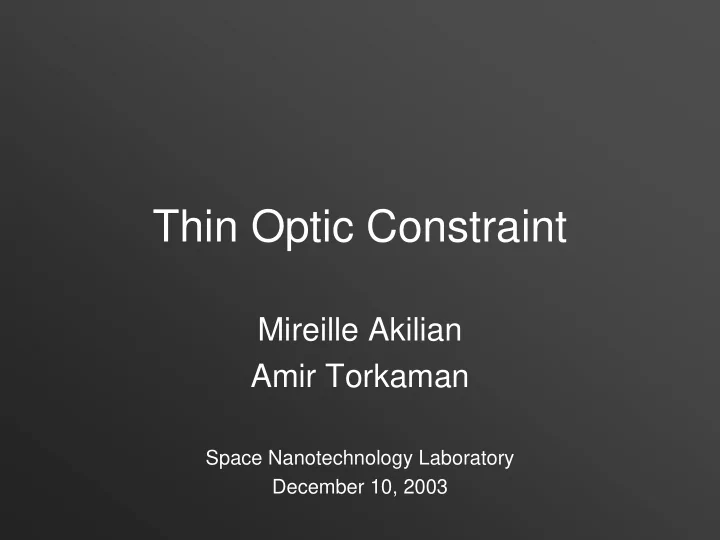

Thin Optic Constraint Mireille Akilian Amir Torkaman Space Nanotechnology Laboratory December 10, 2003
Outline • Problem Statement • Functional Requirements • Strategies • Concepts developed • Detail design • Results and Conclusions
Problem Statement Forces that lead to optic surface warp: •Gravity (weight sag at angle θ , effect linear with θ ; θ < 70 arcsec) •Friction (2-3 µ m error) •Thermal expansion mismatch between optic and device (100’s of microns) Optics flatness on one side < 0.5 µ m peak to valley
Functional Requirements • Reduced effects of thermal expansion and friction • Gravity pitch accuracy 36 arcsec • Placement repeatability: Pitch: 72 arcsec Lateral: 1.5 mm • Ease of inserting optic into device • Optic front surface clear during metrology Three constraint points on surface of rectangular and Optic circular optics
Strategies Air pressure Vacuum Vacuum Double-Sided preloaded air air bearings bearings optic optic Double-Sided flexures optic
Concepts Developed Functional Requirements Design Parameters Hold optic vertically Inclinometer & tilt stage Back surface actuation Optic front surface clear Air gap variation < 3 µ m Small bearing OD Double-Sided Air temperature drop < 0.5 ° C Metal bearings Air Bearings Optimum feeding parameter Acceptable stiffness Flexure length Constrain up to 1.6 mm thick optic Double-Sided Monolithic flexures Minimum centerline misalignment Flexures Account for 1 ° C temperature change Flexure geometry
Double-Sided Air Bearings Design Analysis Y-translation Opposed, inherently constraints compensated bearings Set A A o : constrained by geometry Set o : constrained by geometry (x6) Choose h Choose h Optic Choose A i /A A o Choose A i / o 0.6 < Λξ optimum < 1.1 Vacuum preloaded bearings Choose P s Calculate load capacity and stiffness Λξ d o A o d i A i h P s W k µ m N/ µ m mm 2 mm 2 N/mm 2 mm mm N 7 38.5 0.2 0.13 10 1.5 0.376 3.1 0.172
Double Side Air Bearings Experiment, Results, and Conclusions Load vs. air gap 4 Theoretical load 3 capacity Load (N) Operating 2 region 1 0 0 5 10 15 20 µ Air gap ( m) No friction and thermal mismatch between optic and device No contact deformation Acceptable load capacity and stiffness Design and assembly complexity Moderate to High cost
Double-Sided Flexure Assembly Reference Double- Block sided flexures Bottom Flexure and side tilt flexures stage
Double-Sided Flexures Design Analysis Wire EDM-ed, Monolithic flexures 0.8 mm 1. Vertical flexures 42 mm Allow for optic insertion/removal 21 mm Provide preload 0.6 (k lateral = 2.45E-4 N/ µ m ) mm 6.75 mm ϕ = 2 mm ruby balls 2. Horizontal flexures Accommodate for thermal 2 mm expansion (k lateral = 0.024 N/ µ m) Material Aluminum 6061 T651
Double-Sided Flexures Flexure Deflection and Stress Lateral displacement due to optic thickness After optic placement: Horizontal displacement Vertical parasitic 283 µ m motion Vertical displacement 6.6 µ m
Bottom/Side Flexure Design 2.47 EI = > F F buckle z 2 L = ∆ × M X F z z 3 2 F L M L δ = + x z Fx 3 EI 2 EI EA = k axial L F = x k δ lateral M EI ω = 3.52 n 3 m L flx Outer Diameter (mm) 0.635 Inner Diameter (mm) 0.508 Length (mm) 50 Buckling Force (N) 0.93 Axial Stiffness (N/ µ m) 0.456 Lateral Stiffness (N/ µ m) 2.22E-05
Vertical Reference Flat • Front surface flatness: 0.1um – Optically polished Nickel coated Aluminum block – 90 deg Angle +/- 1 arcsec • Base has tilt adjustment – Resolution: 2 µ rad • Inclinometer resolution: 14 arcsec
Flexure Tilt Stage Design • Allows for pitch / yaw adjustments (2 ± 0.0005 ° ) • Actuation Mechanism: – Fine-thread (#¼-100) screws • Preload Mechanism: – Springs or Belleville washers
System Assembly
Preliminary Experiments � Autocollimator Experiments: • Flexure tilt stage: achieves desired range & accuracy (2 µ rad) • Repeatability Pitch: 1.2 µ rad Yaw: 11 µ rad
Surface Metrology Results � Shack-Hartman Surface Metrology Results: • No local deformations at flexure/optic interface • Placement repeatability 55 nm
Conclusion • Identified and analyzed optic deformation forces – Gravity – Friction – Thermal expansion • Theoretically and experimentally proved the ideal concept of using air bearings • Designed and built an optic holding device using flexures • Future Improvements: – Reference flat must be polished – Systematic and repeatable optic placement procedure – Further surface metrology experiments
Recommend
More recommend